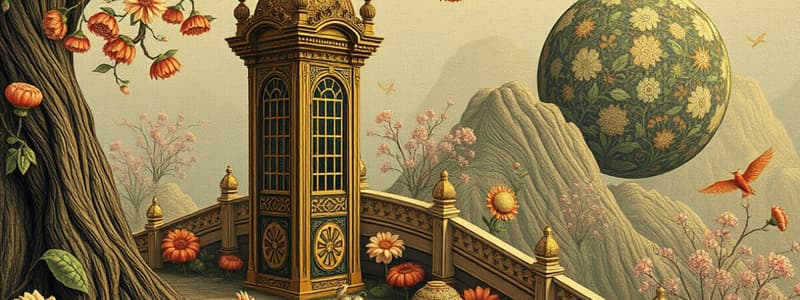Podcast
Questions and Answers
This monumental celebration of aesthetics of letterforms at home which two _____ genius is a milestone in the history of graphic design.
This monumental celebration of aesthetics of letterforms at home which two _____ genius is a milestone in the history of graphic design.
blanks
Who established a printing and bookselling firm in Paris in 1713?
Who established a printing and bookselling firm in Paris in 1713?
Francois Didot
What innovative paper did Francois Ambroise Didot introduce in 1780?
What innovative paper did Francois Ambroise Didot introduce in 1780?
Highly finished, smooth paper of wolves design
In which year did Francois Ambroise Didot revise Fournier's typographic measurement system?
In which year did Francois Ambroise Didot revise Fournier's typographic measurement system?
Who was the older son of Francois Didot and took charge of his father's printing office?
Who was the older son of Francois Didot and took charge of his father's printing office?
What notable invention did Firmin Didot create?
What notable invention did Firmin Didot create?
Who is known as the father of wood engraving?
Who is known as the father of wood engraving?
What was William Blake known for in the realm of graphic design?
What was William Blake known for in the realm of graphic design?
Which publisher chose William Bulmer to print the dramatic works of Shakespeare?
Which publisher chose William Bulmer to print the dramatic works of Shakespeare?
What is Romain du Roi?
What is Romain du Roi?
What is a folio?
What is a folio?
What does 'old style' refer to?
What does 'old style' refer to?
What distinguishes Transitional Roman typefaces?
What distinguishes Transitional Roman typefaces?
What is Rococo?
What is Rococo?
Define 'pouce'.
Define 'pouce'.
What is a point in typography?
What is a point in typography?
What is a type family?
What is a type family?
Describe engraving.
Describe engraving.
What is packing in letterpress printing?
What is packing in letterpress printing?
What is Paper with laid finish?
What is Paper with laid finish?
What is Calendaring paper?
What is Calendaring paper?
What are Cartesian coordinates?
What are Cartesian coordinates?
What does a line graph do?
What does a line graph do?
Who was Giambattista Bodoni?
Who was Giambattista Bodoni?
What is Romanticism?
What is Romanticism?
What did John Baskerville contribute to typography?
What did John Baskerville contribute to typography?
What is the significance of Pierre Simon Fournier le Jeune?
What is the significance of Pierre Simon Fournier le Jeune?
Who was William Playfair?
Who was William Playfair?
Flashcards
Romain du Roi
Romain du Roi
A typeface commissioned by King Louis XIV for the royal printing office, known for its high contrast between thick and thin strokes, sharp horizontal serifs, and balanced letter forms.
Folio
Folio
A sheet of paper folded vertically to create four pages.
Old Style
Old Style
A term referring to the Venetian Roman type design tradition, characterized by its calligraphic features and varying stroke widths.
Transitional Roman
Transitional Roman
Signup and view all the flashcards
Rococo
Rococo
Signup and view all the flashcards
Pouce
Pouce
Signup and view all the flashcards
Point
Point
Signup and view all the flashcards
Type Family
Type Family
Signup and view all the flashcards
Engraving
Engraving
Signup and view all the flashcards
Packing
Packing
Signup and view all the flashcards
Laid Finish
Laid Finish
Signup and view all the flashcards
Wove Finish
Wove Finish
Signup and view all the flashcards
Calendaring Paper
Calendaring Paper
Signup and view all the flashcards
Analytic Geometry
Analytic Geometry
Signup and view all the flashcards
Axis
Axis
Signup and view all the flashcards
Cartesian Coordinates
Cartesian Coordinates
Signup and view all the flashcards
Line Graph
Line Graph
Signup and view all the flashcards
Modern Typeface
Modern Typeface
Signup and view all the flashcards
Neoclassicism
Neoclassicism
Signup and view all the flashcards
Miagre and Gras
Miagre and Gras
Signup and view all the flashcards
Pied de Roi
Pied de Roi
Signup and view all the flashcards
Stereotyping
Stereotyping
Signup and view all the flashcards
Editions du Louvre
Editions du Louvre
Signup and view all the flashcards
Romanticism
Romanticism
Signup and view all the flashcards
Wood Engraving
Wood Engraving
Signup and view all the flashcards
Pierre Simon Fournier le Jeune
Pierre Simon Fournier le Jeune
Signup and view all the flashcards
George Bickham the Elder
George Bickham the Elder
Signup and view all the flashcards
John Pine
John Pine
Signup and view all the flashcards
William Caslon
William Caslon
Signup and view all the flashcards
John Baskerville
John Baskerville
Signup and view all the flashcards
René Descartes
René Descartes
Signup and view all the flashcards
William Playfair
William Playfair
Signup and view all the flashcards
Louis Rene Luce
Louis Rene Luce
Signup and view all the flashcards
Giambattista Bodoni
Giambattista Bodoni
Signup and view all the flashcards
Francois Didot
Francois Didot
Signup and view all the flashcards
Francois Ambroise Didot
Francois Ambroise Didot
Signup and view all the flashcards
Pierre Didot
Pierre Didot
Signup and view all the flashcards
Firmin Didot
Firmin Didot
Signup and view all the flashcards
William Blake
William Blake
Signup and view all the flashcards
William Bulmer
William Bulmer
Signup and view all the flashcards
Thomas Bewick
Thomas Bewick
Signup and view all the flashcards
Study Notes
Romain du Roi
- Typeface commissioned by King Louis XIV for the royal printing office.
- Defined by high contrast between thick and thin strokes, sharp horizontal serifs, and balanced letter forms.
Folio
- A paper sheet folded vertically to create four pages.
Old Style
- Refers to the Venetian Roman type design tradition.
Transitional Roman
- Emerged from the Romain du Roi, moving away from traditional calligraphic features.
- Characterized by bracketed serifs and more consistent stroke width compared to old-style fonts.
Rococo
- French artistic style flourishing from approximately 1720 to 1770.
- Featured elaborate ornamentation, asymmetrical designs, and light pastel colors.
Pouce
- An obsolete French unit of measure slightly longer than an inch, divided into 12 lines, each with six points.
Point
- The smallest unit in the Jeune system of type measurement; six points make one line, twelve lines make one pouce.
Type Family
- A group of fonts that are visually compatible, with various weights and styles that can be mixed.
Engraving
- Drawing technique using a graver on a copper plate, popular during the Rococo period for its ornate designs.
Packing
- Material used in letterpress printing placed behind the sheet to ensure smooth impressions, notably utilized by John Baskerville.
Paper Finishes
- Laid Finish: Features horizontal lines created during manufacturing, giving paper texture.
- Wove Finish: Smooth texture achieved by finer mesh wire, eliminating visible marks.
- Calendaring Paper: Hot-pressed for a glossy surface; Baskerville experimented with this technique for better printing results.
Analytic Geometry
- Developed by René Descartes, this geometry integrates algebra with geometric problems and sets the foundation for information graphics.
Axis
- Perpendicular lines used in Cartesian coordinates to plot points on a two-dimensional plane.
Cartesian Coordinates
- Mathematical system for defining points based on two numbers related to horizontal and vertical axes, creating a grid.
Line Graph
- A chart that uses Cartesian coordinates to represent statistical data graphically, introduced by William Playfair in 1786.
Modern Typeface
- A style of Roman type that emerged in the 18th century, characterized by increased contrast and geometric forms.
Neoclassicism
- A movement that revived classical Greek and Roman aesthetics focusing on simplicity, order, and symmetry.
Miagre and Gras
- Types from the Didot foundry: Miagre represented condensed fonts, while Gras depicted expanded styles.
Pied de Roi
- Standard measurement for type sizes in France, established by the Didot foundry.
Stereotyping
- A printing process creating duplicates of relief surfaces through molding, significantly improving printing efficiency.
Editions du Louvre
- A publication by Pierre Didot that epitomized Neo-Classical graphic design, showcasing modern typography and engravings.
Romanticism
- An artistic movement reacting against Neoclassicism, emphasizing imagination and emotion in art.
Wood Engraving
- A technique that cuts across the grain of wood, refined by Thomas Bewick for detailed illustrations in letterpress.
Pierre Simon Fournier le Jeune
- A significant figure in type design who introduced standardized measurement and produced over 4600 type characters.
George Bickham the Elder
- An esteemed English penman and engraver known for the "Universal Penman" book, showcasing penmanship and decoration.
John Pine
- A prominent engraver known for his independent works and intricate engraving techniques for both text and illustrations.
William Caslon
- An influential English type designer whose fonts remained popular for over two centuries, known for legibility and sturdy texture.
John Baskerville
- Printer and typographer who greatly influenced type design with his elegant, transitional styles; known for innovative book layouts and quality print.
René Descartes
- Philosopher and mathematician who developed analytic geometry, crucial for modern graphic design and information representation.
William Playfair
- Scottish author who popularized the use of graphical representations of data, such as line graphs and bar charts.
Louis Rene Luce
- Type designer and punch cutter known for his narrow, condensed types and diverse ornamental designs.
Giambattista Bodoni
- Italian printer and designer who emphasized geometric and mathematical forms in typography, moving away from Rococo styles to modern efficiency.
Francois Didot
- Founder of a family-run print and type founding business, pivotal in advancing type design in France.
Francois Ambroise Didot
- Son of Francois Didot, known for introducing refined paper and developing the point system widely adopted in printing.
Pierre Didot
- The older son of Francois Didot, continuing the family's legacy in type design and printing methods.### Firmin Didot
- Took over father’s printing office post-revolution.
- French government awarded him the Imprimerie Royale’s former printing office at the Louvre.
- Contributed to neo-classical revival with graphic design in a series of additions at the Louvre.
- Published the 1819 specimen of new type characters in Paris.
- Younger son of François Didot, he became head of the Didot type foundry.
- His modern typography exhibits precision beyond that of Bodoni.
- Invented stereotyping, a process for creating duplicate printing surfaces via molding.
- Enabled large-scale production of economical books for wider audiences using stereotyping.
William Blake
- An English poet and artist known for publishing illustrated poetry books.
- Used monochrome etching to combine text and imagery, enhancing artistic expression.
- Personally hand-colored each page with watercolor, creating unique editions.
- His works aimed to transcend graphic design material for spiritual expression.
- The 1789 title page from "The Book of Thel" exemplifies his integration of letterforms into illustrations.
- Considered a precursor to 19th-century romanticism, expressionism, and abstract art with his vivid colors and organic forms.
William Bulmer
- Selected by publishers John and Josiah Boydell and George W. Nicol for printing Shakespeare's dramatic works from 1792 to 1802.
- Printed significant volumes including William Somerville’s "The Chase" in 1796.
- Combined Bodoni and Didot’s clean designs with traditional English readability and warmth.
- Collaborated with Thomas Bewick for illustrations, enhancing the visual appeal of his printed works.
Thomas Bewick
- Renowned as the father of wood engraving.
- Developed a fine engraving technique using a graver to achieve intricate effects by cutting across the grain of Turkish boxwood blocks.
- Created cuts with the grain on softer woods to enhance detail.
- Gained recognition for his publication "A General History of Quadrupeds" in 1790.
- His wood engraving techniques became a major illustration method in letterpress printing until the rise of photomechanical halftones.
Studying That Suits You
Use AI to generate personalized quizzes and flashcards to suit your learning preferences.




